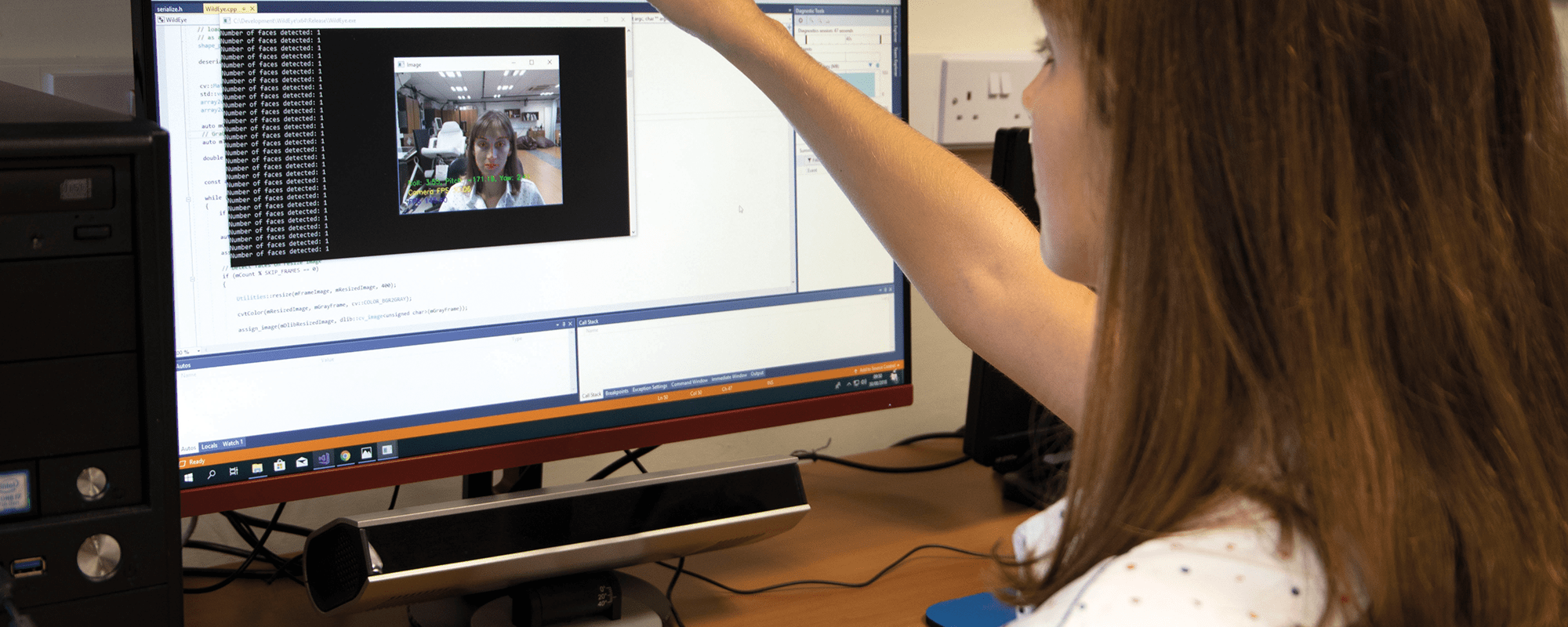Since 5G was announced, it has polarised public opinion. Many claim that it will revolutionise the world, while others fear that it poses a threat to our health. In Malta, the installation of new antennas on rooftops and public spaces has fueled debate. But what is 5G, how does it work, and is it actually dangerous? THINK speaks with Dr Julian Bonello, a researcher from UM’s Department of Physics, to separate fact from fiction.
Continue readingDrawing with Data
Artist Matthew Attard uses eye-tracking to spark intriguing conversations, challenging us to see the world through new eyes and explore the intersection of art and activism.
Continue readingEyes front!
How often do your date’s eyes glance down at your chest? Which products do people notice in a supermarket? How long does it take you to read a billboard?
Eye trackers are helping researchers around the world answer questions like these. From analysing user experience to developing a new generation of video games, this technology offers a novel way of interacting with machines. People with disabilities, for example, can use them to control computers. A team at the Department of Systems and Control Engineering (University of Malta) is using a research-grade eye-gaze tracker, worth around €40,000, to test technologies they are planning to commercialise soon.
Continue readingLiving with a rare disease
Author: Clayton Axiak
Picture yourself waking up one morning with a severe, relentless itch that no clinician or diagnostic tool can understand. Your life would be thrown off kilter. Quality of life would suffer financially, psychologically, and socially as you try to look for a glimmer of light at the end of the tunnel. This is what life is like for most people living with a rare disease.
Often barraged with terms like ‘unknown’ or ‘undiagnosed’, matters can get even more challenging when the condition becomes more elusive or develops life-threatening consequences. And all of this is exacerbated by inequities in treatment and high costs of the few existing drugs that are available.
By EU standards, a rare disease is one that affects fewer than one in 2,000 individuals. And these ‘less common’ ailments are difficult to raise monies for to research, leaving large gaps in scientific and medical literature. One such disease is the poorly understood Idiopathic Hypogonadotropic Hypogonadism (IHH).
Characterised by the absence of puberty and infertility, IHH can be compounded by potentially severe characteristics such as congenital heart disease, osteoporosis at a young age, and early onset of Alzheimer’s disease.
Its cause is usually a genetic anomaly, but a single genetic change can affect two people very differently. This gives rise to an unparalleled complexity that makes the cause harder to decipher. Symptoms are not clear-cut and sometimes mask the actual underlying cause, bringing about misdiagnosis and delayed treatment. Timely diagnosis is crucial for successful treatment that enables the patient to achieve puberty and induce fertility. But this is not always possible.
Under the guidance of Dr Rosienne Farrugia, I am currently analysing and expanding upon a preliminary assessment of IHH in Malta using high-throughput sequencing (HTS) technology (conducted by Adrian Pleven). With HTS, we can read a person’s entire DNA sequence and attempt to identify differences in the DNA code which lead to such diseases.
What the team has found is that some genetic variants typical of IHH are more common in the Maltese population when compared to mainland Europe and African populations. This is likely due to the reduced genetic variation of our population, shaped by successive events of population reduction and expansion throughout our history.
By mapping the genetic cause of diseases prevalent on our islands, we can help medical consultants to employ specific screening tests that are tailored for local patients suffering from IHH. Such advancements in genomic technology and personalised medicine can make a huge impact on people’s lives. And not only to those suffering from IHH; researching one disease, however rare it may be, can shed light on mechanisms that prove useful in treating many others, ensuring that when it comes to health, no one is left behind.
This research project is being carried out as part of a Ph.D. program in Applied Biomedical Sciences at the Faculty of Health Sciences.
To patent or not to patent?
As universities and research institutions look to protect the knowledge they develop, András Havasi questions time frames, limited resources, and associated risks.

The last decade has seen the number of patent applications worldwide grow exponentially. Today’s innovation- and knowledge-driven economy certainly has a role to play in this.
With over 21,000 European and around 8,000 US patent applications in 2018, the fields of medical technologies and pharmaceuticals—healthcare industries—are leading the pack.
Why do we need all these patents?
A patent grants its owner the right to exclude others from making, using, selling, and importing an invention for a limited time period of 20 years. What this means is market exclusivity should the invention be commercialised within this period. If the product sells, the owner will benefit financially. The moral of the story? A patent is but one early piece of the puzzle in a much longer, more arduous journey towards success.
Following a patent application, an invention usually needs years of development for it to reach its final product stage. And there are many ‘ifs’ and ‘buts’ along the way to launching a product in a market; only at this point can a patent finally start delivering the financial benefits of exclusivity.
Product development is a race against time. The longer the development phase, the shorter the effective market exclusivity a product will have, leaving less time to make a return on the development and protection costs. If this remaining time is not long enough, and the overall balance stays in the negative, the invention could turn into a financial failure.
Some industries are more challenging than others. The IT sector is infamous for its blink-and-you-miss-it evolution. The average product life cycle on software has been reduced from three–five years to six–12 months. However, more traditional sectors cannot move that quickly.
The health sector is one example. Research, development, and regulatory approval takes much longer, spanning an average of 12–13 years from a drug’s inception to it being released on the market, leaving only seven to eight years for commercial exploitation.
So the real value of a patent is the effective length of market exclusivity, factored in with the size of the market potential. Can exclusivity in the market give a stronger position and increase profits to make a sufficient return on investment? All this makes patenting risky, irrespective of the technological content—it is a business decision first and foremost.
Companies see the opportunity in this investment and are happy to take the associated risks. But why does a university bother with patents at all and what are its aims in this ‘game’?
Universities are hubs of knowledge creation and today’s economy sees the value in that. As a result, research institutions intend to use and commercialise their know-how. And patenting is an essential part of that journey.
The ultimate goal and value of a patent remains the same, however, it serves a different purpose for universities. Patents enable them to legally protect their rights to inventions they helped nurture and claim financial compensation if the invention is lucrative. At the same time, patent protection allows the researchers to freely publish their results without jeopardising the commercial exploitation of the invention. It’s a win-win situation. Researchers can advance their careers, while the university can do its best to exploit the output of their work, bolster its social impact, and eventually reinvest the benefits into its core activity: research.
At what price?
Patenting may start at a few hundred or thousand euros, but the costs can easily accumulate to tens or even hundreds of thousands over the years. However, this investment carries more risk for universities than for companies.
Risks have two main sources. Firstly, universities’ financial capabilities are usually more limited when compared to those of businesses. Secondly, universities are not the direct sellers of the invention’s eventual final product. For that, they need to find their commercial counterpart, a company that sees the invention’s value and commercial potential.
This partner needs to be someone who is ready to invest in the product’s development. This is the technology transfer process, where the invention leaves the university and enters the industry. This is the greatest challenge for university inventions. Again, here the issue of time raises its head. The process of finding suitable commercial partners further shortens the effective period of market exclusivity.
A unique strategy is clearly needed here. Time and cost are top priorities. All potential inventions deserve a chance, but risks and potential losses need to be minimised. It is the knowledge transfer office’s duty to manage this.
We minimise risks and losses by finding (or trying to find) the sweet spot of time frames with a commercial partner, all while balancing commercial potential and realistic expectations. The answer boils down to: do we have enough time to take this to market and can we justify the cost?
Using cost-optimised patenting strategy, we can postpone the first big jump in the costs to two and a half years. After this point, the costs start increasing significantly. The rule of thumb is that about five years into a patent’s lifetime the likelihood of licensing drops to a minimum. So on a practical level, a university invention needs to be commercialised very quickly.
Maintaining a patent beyond these initial years can become unfeasible, because even the most excellent research doesn’t justify the high patenting costs if the product is not wanted by industry. And the same applies for all inventions. Even in the health sector, despite product development cycles being longer, if a product isn’t picked up patents can be a huge waste of money.
Patenting is a critical tool for research commercialisation. And universities should protect inventions and find the resources to file patent applications. However, the opportunities’ limited lifetime cannot be ignored. A university cannot fall into the trap of turning an interesting opportunity into a black hole of slowly expiring hopes. It must be diligent and level-headed, always keeping an ear on the ground for the golden goose that will make it all worth it.
Science and coffee, anyone?
In an age of misinformation, having a grasp on current affairs and research is essential for us to be active, responsible citizens. Gillianne Saliba writes about the dire need for more dialogue and engagement from citizens and scientists alike.

For many, science is far removed. It’s just a subject they had to take at school. Or the star of crazy stories on newspapers, or videos and memes on social media. Opposing views are a dime a dozen. And sometimes it’s very hard to discern between them; what’s right? what’s wrong? ‘It’s complicated,’ they say, ‘it’s hard’, and so most people move on, letting others do all the talking. As a result, science and citizens have had a rocky relationship. But when the issues being discussed relate to health, technology, and our environment, that is, when they affect us directly, we need to be able to engage.
Science Communication (SciComm for short) can offer a solution to this problem.
SciComm can take many forms. Articles, films, museum exhibitions; you name it. In the wake of a scientific knowledge-gap in the community, SciComm has taken root and has been rapidly growing over the last 40 years. Researchers want to share their ideas and get citizens’ input, gauge interest, and see what others have to say.
Enter Malta Café Scientifique.
To create a safe space where people can chat about science, Malta Café Sci organises monthly science communication events in Valletta where researchers and professionals discuss topics of interest with attendees. Entrance is completely free and open to all, which attracts a diverse audience.

What makes Malta Café Sci special is how it prioritises the public, putting their learning experience first. The events are tailored to them. Speakers keep their talks short and succinct, taking complex scientific concepts and breaking them down, discussing how the research can impact society. The Q&A session that follows is often far longer than the talk itself, opening up a dialogue within the audience. The elitist mantra of ‘it’s complicated’ is so far gone that talks, and the following question and answer portion of the evening, are put to bed with closing drinks where speakers and audience members can have one-on-one time, discussing the topic of the day.
I have been volunteering as an organiser with Malta Café Scientifique for the last nine months. Through the experience, I have gained marketing and public speaking skills.
More importantly, I have had the privilege of a front row seat to pivotal moments in people’s lives—the moment when perception shifts.
I’ve often had audience members come up to me after an event to tell me how the talk changed their ideas. How they are learning to be more receptive but also critical about what they learn and read online. Some point out how they usually steer clear of such events, with many wrongly thinking they aren’t smart enough for them, only to find that they not only understand, but can also participate.
Aside from all this, Malta Café Scientifique is also conducting its own research. Led by Café Sci’s project manager Danielle Martine Farrugia, we are evaluating and interviewing different science communicators about their practices. We’re also evaluating the initiative to understand its contribution to science communication in Malta.
What we can already see is that Malta Café Sci is living, breathing proof of how people can come together when dialogue is open and welcoming. It is empowering local researchers to share their findings with citizens while giving community members the chance to learn and weigh in on work that may have ramifications for them. Where a learning process is no longer from expert to layman, but a continuous sharing of information in both directions.
Note: For more about Malta Café Scientifique’s next events, or if you want to get involved, see its Facebook page or Instagram @maltacafesci. Or email us on cafesci@mcs.org.mt.
STEM ambassadors thrashing stereotypes
Over the last four decades, STEM industries have risen to great heights. Scientific, technological, engineering, and mathematical minds have been called to rally. And the demand continues. How can you contribute?
Few would dispute that technological and scientific advancements dominate the 21st century. Adverts provide ample proof. From tablets to smartphones, to robot home appliances and driverless cars, our world is changing fast. As a result, we are now living in a global knowledge-based economy where information can be considered as the highest form of currency. This reality comes with both benefits and challenges.
Statistics from 2013’s European Company Survey show that 39% of European Union-based firms had difficulty recruiting staff with STEM skills. Malta is no exception. Another report in 2018 showed that people with STEM careers are still in short supply locally, especially in the fields of healthcare, ICT, engineering, and research. So, while the jobs are available, there aren’t enough people taking up STEM careers, and this is holding Malta back.

There are many reasons for this trend. For one, Malta has a low number of tertiary level graduates; the third lowest in the EU. An array of harmful stereotypes can also shoulder some blame. The ‘fact’ that people in math, science, and technology ‘don’t have a social life’ is unhelpful. The ‘nerd’ image is still prevalent, especially among the younger generations that are still in primary and secondary school. Then there is the ‘maleness’ associated with STEM jobs and industries. According to Eurostat statistics, in 2017, from 18 million scientists and engineers in the EU, 59% were men and 41% women.
Still, this is far from the whole picture.
Employers have reported instances where, despite having enough graduates to fill roles, applicants did not possess the right non-technical skills for the job. This was especially true for abilities such as communication, creative thinking, and conflict resolution.
Many were unprepared to work in a team, to learn on the job, and to problem solve creatively. This is a real concern, especially for the country’s future. At the rate with which markets are evolving, a decade from now young people will be applying for jobs that do not exist today, and the country needs to prepare students for these roles. And it has to start now.
The Malta Council for Science and Technology (MCST) is trying to do this through an Erasmus+ project called RAISE. They are launching an Ambassador Programme to empower young students to take up the STEM mantle. STEM Career Cafés are going to be popping up in schools all over Malta, alongside a Career Day at Esplora aimed to inform and inspire. This is where you come in.
They want undergraduates from the University of Malta and MCAST to work with Esplora by sharing your experiences in STEM and telling your stories to encourage those who may be considering a STEM career. STEM Ambassadors will gain important public engagement skills while making research and science careers more accessible.
STEM is crucial in our contemporary world; our economies depend on it. It has completely changed the way we live and opened up new prospects for a future we never imagined. For those who have already made up their mind to be a part of it, there is now the opportunity to empower others and guide them in finding their own path.
Note: To become a STEM Ambassador, email programmes@esplora.org.mt or call 2360 2218.
The MCST, the University of Malta, and the Malta College of Arts, Science and Technology have embarked on a national campaign to promote STEM Engagement. Its first activity was a National STEM Engagement Conference.
Enter the swarm
Author: Jean Luc Farrugia

Once upon a time, the term ‘robot’ conjured up images of futuristic machines from the realm of science fiction. However, we can find the roots of automation much closer to home.
Nature is the great teacher. In the early days, when Artificial Intelligence was driven by symbolic AI (whereby entities in an environment are represented by symbols which are processed by mathematical and logical rules to make decisions on what actions to take), Australian entrepreneur and roboticist Rodney Brooks looked to animals for inspiration. There, he observed highly intelligent behaviours; take lionesses’ ability to coordinate and hunt down prey, or elephants’ skill in navigating vast lands using their senses. These creatures needed no maps, no mathematical models, and yet left even the best robots in the dust.
This gave rise to a slew of biologically-inspired approaches. Successful applications include domestic robot vacuums and space exploration rovers.
Swarm Robotics is an approach that extends this concept by taking a cue from collaborative behaviours used by animals like ants or bees, all while harnessing the emerging IoT (Internet of Things) trend that allows technology to communicate.
Supervised by Prof. Ing. Simon G. Fabri, I designed a system that enabled a group of robots to intelligently arrange themselves into different patterns while in motion, just like a herd of elephants, a flock of birds, or even a group of dancers!

I built and tested my system using real robots, which had to transport a box to target destinations chosen by the user. Unlike previous work, the algorithms I developed are not restricted by formation shape. My robots can change shape on the fly, allowing them to adapt to the task at hand. The system is quite simple and easy to use.
The group consisted of three robots designed using inexpensive off-the-shelf components. Simulations confirmed that it could be used for larger groups. The robots could push, grasp, and cage objects to move them from point A to B. To cage an object the robots move around it to bind it, then move together to push it around. Caging proved to be the strongest method, delivering the object even when a robot became immobilised, though grasping delivered more accurate results.
Collective transportation can have a great impact on the world’s economy. From the construction and manufacturing industries, to container terminal operations, robots can replace humans to protect them from the dangerous scenarios many workers face on a daily basis.
This research project was carried out as part of the M.Sc. in Engineering (Electrical) programme at the Faculty of Engineering. A paper entitled “Swarm Robotics for Object Transportation” was published at the UKACCControl 2018 conference, available on IEEE Xplore digital library.
Redesigned hip joints need a simulator
People are living longer than ever. But a long life has its price. With age come more diseases and health issues, such as hip problems that can limit a person’s mobility.
Hip replacement procedures have become common, although implants have a lifespan too. It might happen that a hip replacement you get at 60 needs to be replaced at 75. This is not the ideal scenario.
To minimise these cases, researchers are testing new materials and designs to prolong prostheses’ lifespans. These potential solutions need to be tested, but each test costs tens of thousands of euro. Enter, the University of Malta’s hip joint simulator.

The hip joint simulator is a machine that replicates the joint movements and loads imposed on the human hip. To do so, the simulator uses three stainless steel frames, each of which can be controlled independently using motors. These motors act as the ‘muscles’ of the hip, programmed to replicate the walking cycle during testing.
When it comes to simulating load and forces, a mechanism can load the implants with weights of up to 300kg in a fraction of a second. This emulates what happens while walking, when the weight of the body rests on one leg due to the body’s shift in the centre of gravity. While running, inertial forces can cause the hip to sometimes take five times a person’s body weight.
Finally, to simulate the environment inside the human body, researchers use a specialised solution that mimics the bodily fluids surrounding the hip joint. They even warm the fluid to imitate body temperature.
The hip joint simulator forms part of the MaltaHip project that intends to radically redesign hip implants to give them the longer lifespan patients want and need. Watch this space for more.
The MALTAHIP project is funded by the Malta Council for Science and Technology through FUSION: The R&I Technology Development Programme 2016 (R&I-2015-023T).
Research to business plan: A metamorphosis
Author: Michelle Cortis

In recent years, there has been a shift in the relationship between research and commercial industries. Commercial viability almost always comes into question for ongoing research. Commercialisation can be a boon. When a research project has demonstrated its potential to become a viable business, funding opportunities increase, meaning the research can be turned into a product or service that people can use.
In 2018, as part of a Masters in Knowledge-Based Entrepreneurship, I analysed the commercial potential of an ongoing University of Malta project. I conducted an in-depth market feasibility study on Prof. Ing Joseph Cilia’s Smart Micro Combined Heat and Power System, a device that can be fitted into homes and offices to deliver heat as a by-product of electricity, reducing energy costs. Many EU countries are setting up incentives to make these systems more feasible and attractive to consumers.
For my dissertation, I developed a business plan for the research team. An engineer myself, and having earned a Masters by Research back in 2014, this was different to anything I had done before. My supervisors, Prof. Russell Smith and Dr Ing. Nicholas Sammut, helped me find the right balance between utilising my technical knowledge whilst also analysing the product’s commercial potential. Even my language changed through the process; I began to speak of ‘euros per day’ rather than ‘kilowatt hours’. I learnt to differentiate between technological features and what real benefits future users would gain.
Being presented with a physical product, initially one may assume that it is to be sold to customers, or protected through a patent and licensed to the private sector. However, my market analysis revealed new target audiences that had not been thought of before. Selling the device was not the only way to exploit the project’s commercial potential. What if we leased the product instead of selling it? Should we continue developing the product or is it already innovative enough? What if we developed a spin-out—would it be too expensive or is it worth the investment?
By analysing a project through a commercial lens, all these questions arise, pointing out potential ways to make a good project great. But what makes a good business plan great is when all these questions are answered.
The Project ‘A Smart Micro Combined Heat and Power System’ is financed by the Malta Council for Science & Technology, for and on behalf of the Foundation for Science and Technology through the FUSION: R&I Technology and Development Programme.
Are you carrying out research at the University of Malta which you think may have commercial potential? If so, contact the Knowledge Transfer Office on knowledgetransfer@um.edu.mt











